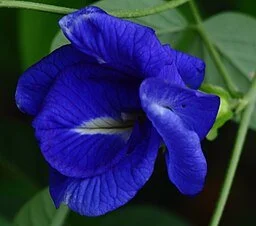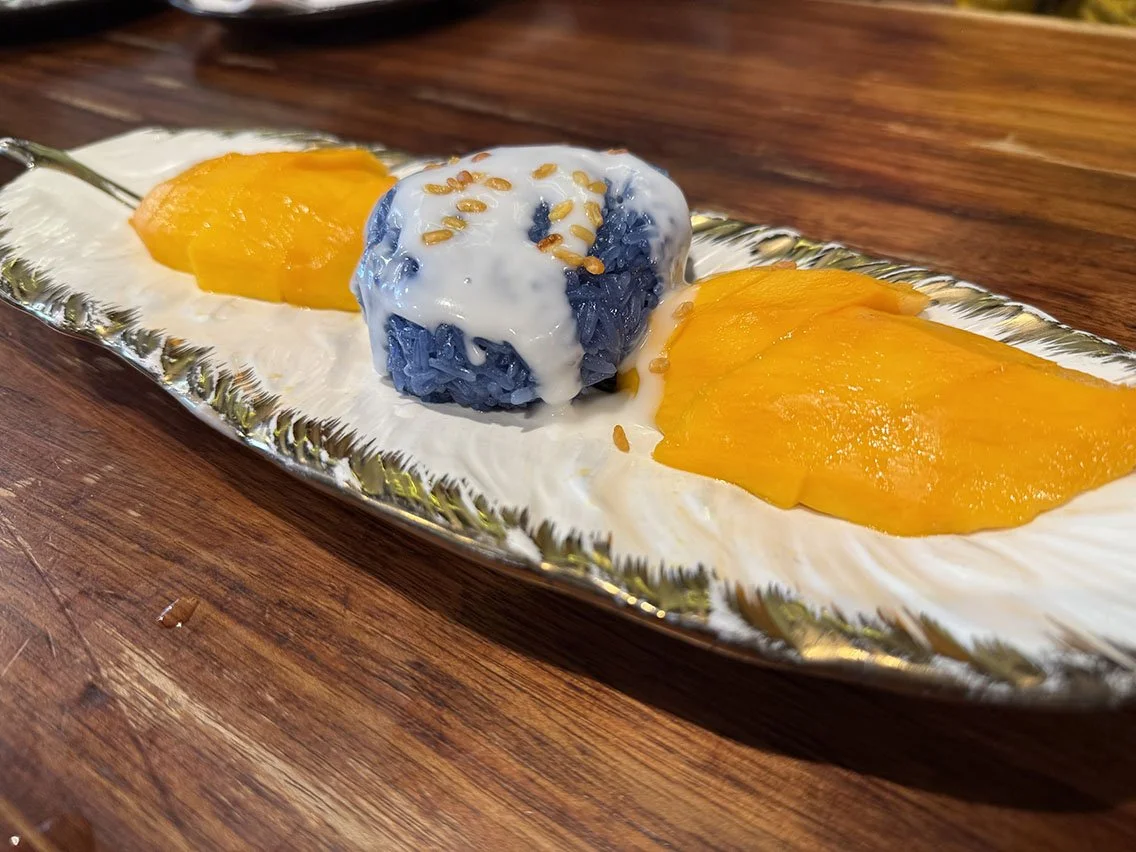Aparajita – The Undefeated Herb of Ayurveda
Ayurveda teaches us that herbs are not just substances to be studied—they are beings to be known, companions on the journey toward balance. The deeper invitation is always to look around you: What grows near you? What calls your attention? What plants keep showing up—on walks, in meals, in moments of pause?
I’ve been sharing various herbs that grow in California, particularly in the Bay Area. Ayurveda is deeply rooted in connecting with your local environment—its flora and fauna—so you can cultivate a meaningful relationship with the plants around you. This practice not only deepens your understanding of how to use each herb but also brings a logical, intuitive clarity to your learning, which is a fundamental aspect of Ayurvedic wisdom.
That clarity arrived for me recently in an unexpected moment with my son. We ordered sticky rice with mango on a warm day—something familiar. But this time, the rice was a luminous blue. My son, always curious, asked the server why. The answer? Butterfly pea flower—soaked overnight to color the rice and lend it a cooling quality.
This wasn’t just a pretty hue. It was Aparajita, the very herb I had studied in Ayurvedic texts for years. Suddenly, it was no longer abstract—it was right there on our plate, a quiet participant in our lunch and our learning. I watched my son connect the dots between color, plant, and season. And I felt something shift: this was no longer information. It had become an experience.
A few weeks later, at a Persian café, a friend’s mocktail arrived in that same brilliant blue. And I smiled. Aparajita had found us again.
In Thailand, it appears in herbal teas. In Southeast Asia, it’s used to dye desserts and drinks. In California cafés, it is gaining popularity for its calming and visually enchanting presence. Aparajita moves gently, but purposefully, through kitchens, cultures, and conversations—reminding us of the grace with which plants travel, belong, and heal.
The Herb Behind the Hue
Aparajita, literally meaning “the one who cannot be defeated”, is a revered herb in Ayurveda known for its vast spectrum of therapeutic actions. Botanically identified as Clitoria ternatea Linn., it belongs to the Fabaceae family and is native to tropical and subtropical regions of Asia, Africa, and Central America. In India, it is often seen climbing on fences in gardens and temple courtyards, its deep blue or white flowers quietly woven into ritual offerings.
Classical Ayurvedic texts categorize Aparajita under Guduchyadi Varga and Palashadi Varga, both associated with detoxifying and rejuvenating properties. It is praised in works such as Bhavaprakasha Nighantu, Kaiyadeva Nighantu, and Sushruta Samhita for its Medhya (nootropic), Vishaghna (detoxifying), and Shothahara (anti-inflammatory) effects.
Pharmacological Profile
Attribute |
Description |
|---|---|
Sanskrit Name |
Aparājitā / Girikarnikā |
Botanical Name |
Clitoria ternatea Linn |
Family |
Fabaceae |
Rasa (Taste) |
Katu (Pungent), Tikta (Bitter), Kashaya (Astringent) |
Guna (Qualities) |
Laghu (Light), Ruksha (Dry) |
Veerya (Potency) |
Sheeta (Cooling) |
Vipaka |
Katu (Pungent) |
Prabhava (Unique Action) |
Vishaghna, Medhya |
Therapeutic Actions (Karma)
● Medhya – Enhances memory and concentration
● Shirovirechanopaga – Supports therapies for cleansing the head region
● Vishaghna – Neutralizes toxins and poisons
● Kusthaghna – Helps in managing skin diseases
● Mutravirechaka – Promotes healthy urination
● Shothahara – Reduces inflammation and oedema
● Vayasthapana – Supports longevity and tissue rejuvenation
● Vranaropaka – Aids wound healing and tissue regeneration
Parts Used: Root, Stem, Leaf
These are employed in both internal and external therapeutic preparations.
Classical Reference
Aparājite kaṭu medhye śīte kaṇṭhye sudṛṣṭide ।
Kuṣṭha-mutra-tridoṣāma-śothavranaviṣāpahe ॥
(Bhavaprakasha Nighantu, Guduchyadi Varga, Sloka 111–112)
Translation: Aparajita is pungent and intellect-enhancing, cooling in potency, beneficial for the throat, and improves vision. It treats skin diseases, urinary disorders, tridoshic imbalance, swelling, wounds, and poisons.
Aparajita vs. Shankhapushpi
A common point of confusion in clinical practice is the mix-up between Aparajita (Clitoria ternatea) and Shankhapushpi (Convolvulus pluricaulis or C. prostratus). While both are described as Medhya Rasayana (cognitive tonics), their botanical identity and therapeutic nuances differ significantly. Accurate plant identification becomes especially important in neurocognitive formulations to preserve therapeutic integrity.
Where Can You Find This Plant?
If you're in the Bay Area and curious to meet Aparajita in person, I recently discovered Kula Nursery—a wonderful resource for those looking to grow Ayurvedic herbs locally. They carry a variety of plants that thrive in this climate, including Butterfly Pea Flower (Aparajita). It's a beautiful way to begin forming your own relationship with this undefeated herb.
By Geetanjali Chakraborty
Geetanjali is a NAMA-certified AD who specializes in leveraging diet and lifestyle as the primary pillars of holistic health. Central to her Ayurvedic philosophy is the idea of harmonizing with one’s natural environment, advocating for the cultivation of personal herbal gardens rooted in local conditions. Beyond functional health benefits. She emphasizes the profound mental well-being gained from nurturing a relationship with healing plants, integrating them as cherished members of one’s family.




